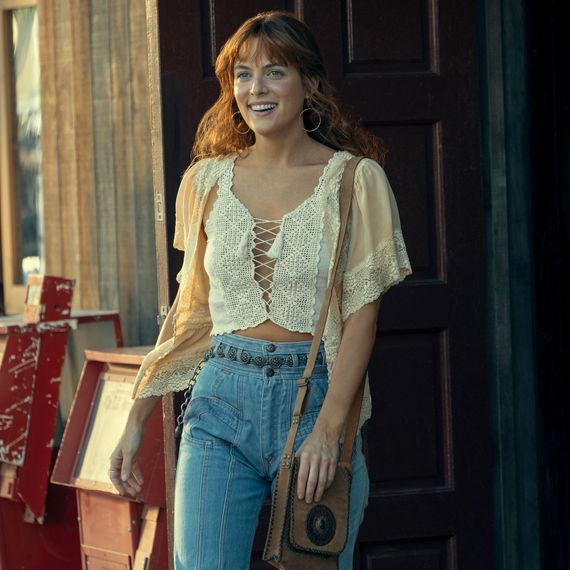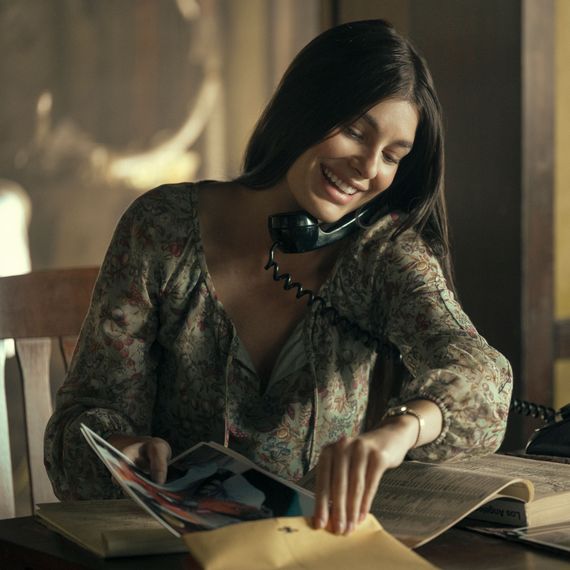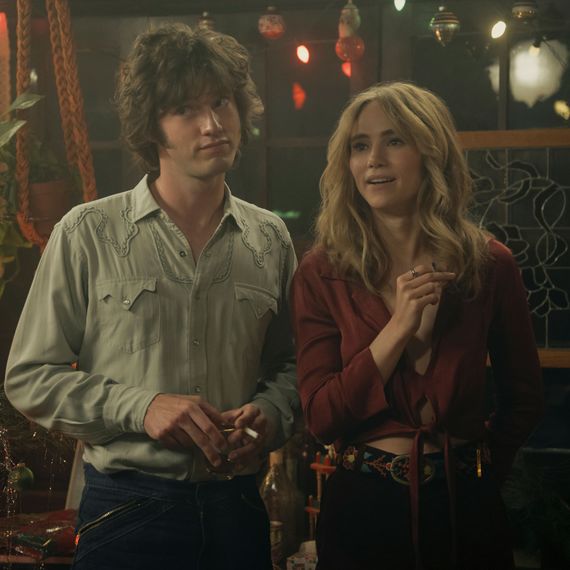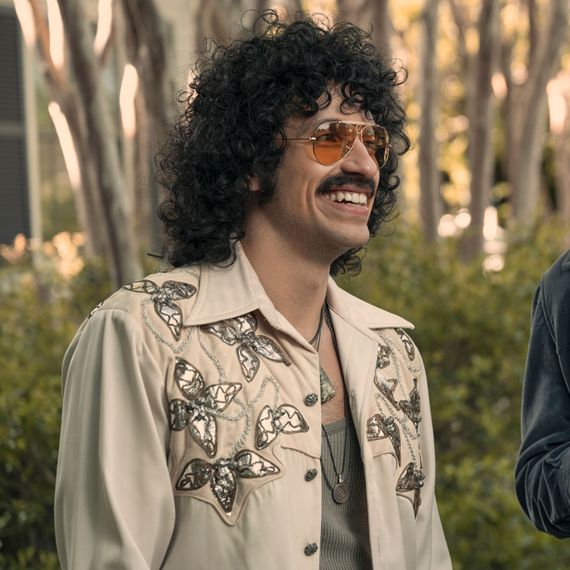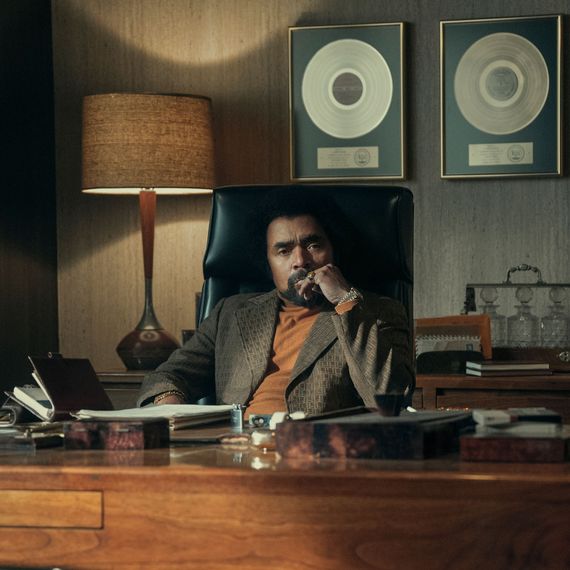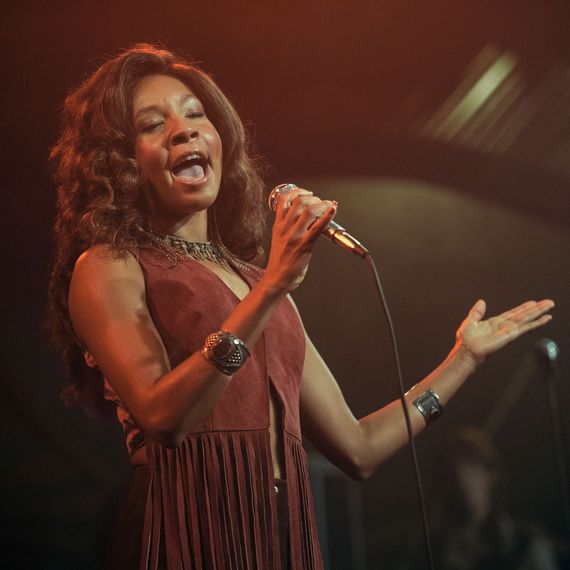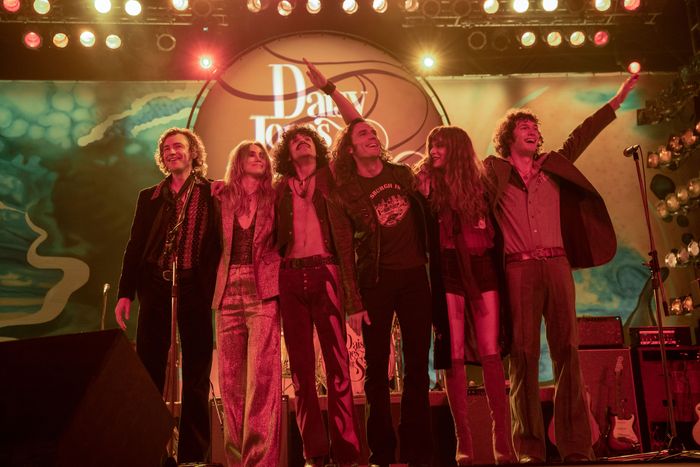
The biggest hurdle in adapting a novel like Taylor Jenkins Reid’s Daisy Jones & the Six is reproducing the format: a transcribed oral history of a fictional rock band loosely inspired by Fleetwood Mac, told by interviewees speaking 40 years after their final performance. But despite some tweaks — the interviews take place only 20 years later in the series — Prime Video’s new ten-episode miniseries has accomplished the task.
The first few episodes suffer a bit from some common translation pitfalls. Daisy Jones (Riley Keough) and Billy Dunne (Sam Claflin), the co-leads, don’t meet until halfway through the third episode, and it feels as if the story is waiting until that point to really take off — unlike the book, in which the long wait allows for a thorough exploration of the band’s various backstories. But a documentary style is a natural fit for a novel written as an oral history, and the later episodes come alive especially by structuring their stories around events or periods of time: a daylong brainstorming session in which Daisy and Billy’s creative partnership really takes off, for example, or a trip to the Greek island of Hydra in which none of the Six appear.
In making the jump from page to screen, Daisy Jones & the Six has, for the most part, very faithfully re-created the reading experience. But as with any adaptation, certain details don’t make the cut, and characters are inevitably altered in significant or minor ways, for good or ill. Here are the characters from Reid’s novel, sorted by how faithfully the series depicts them onscreen.
Mostly Faithful to the Book
Daisy Jones
One of the series’ canniest choices is casting Riley Keough as Daisy Jones, the hurricane at the center of this story. Performances in movies such as The Lodge and Zola have proven Keough’s ability to go big, but it’s her gift for subtlety that plays a critical role in making Daisy feel like more than just a Stevie Nicks knockoff. She’s beautiful and charismatic, and you want to both party with her and watch her work — but, as in the book, the genius Daisy and the flighty, unreliable addict Daisy are a package deal.
Billy Dunne
The front man of the Six can be every bit as selfish and unlikable as he was in the book, and the broad strokes of his character arc are the same. Sam Claflin has good chemistry with Keough, keeping Billy’s simmering desires just below the surface as Daisy breaks through his defenses and they tentatively grow closer. He nails the way Billy’s standoffishness disguises both a deep jealousy of the new vocalist stealing his thunder and a deep, natural connection with her.
Where the series falls short regarding Billy is in cutting down on one of the novel’s richest themes: the war between singular genius and artistic collaboration. There are some fun songwriting scenes, to be sure, but I craved more, and I’m not sure I ever fully believed Billy was as talented as he was supposed to be. At one point in the book, while considering the band’s hit album (and Rumours stand-in) Aurora, keyboardist Karen Sirko speculates, “Was the album our best one because Billy was forced to let us in on the composing and arranging from the outset? I think so. Was it the best one because Billy ultimately took the reins back? Because Teddy knew when to make Billy listen to other ideas and when to let him run the show? Was it only the best because of Daisy? I have no idea. I spent a lot of time thinking about it and I have no idea.” The TV show rarely stops to meditate on the same questions.
Camila Dunne
Camila is arguably the most compelling character of the novel: the wife of an unfaithful, drug-addicted rock star who accepts him for his faults and makes the choice, every day, to forgive his many transgressions. The series integrates Camila into the band dynamic early on, letting her move to L.A. with Billy immediately rather than breaking up with him and later reconciling. That allows her to make stronger connections with the other band members and establish her agency in ways that might occasionally prove surprising to readers of the book. But mostly this is still the Camila Dunne we know. And Camila Morrone is a natural fit in the ensemble, always letting us in on her character’s central internal conflict: How can you stay with the man you believe to be your soulmate when you see him falling for somebody else?
Graham Dunne and Karen Sirko
The secondary love story in Daisy Jones & the Six follows the same general path as in the book with a few detours and added complications, including a trip to the beach, where Karen starts to realize how she feels about her closest bandmate. Will Harrison and Suki Waterhouse sell it well, especially the latter.
Warren Rhodes/Rojas
In both the book (in which his last name is Rhodes) and the series (in which it’s Rojas), Warren is the chill, funny drummer who just wants to hang out and have fun, unencumbered by the tortured drama and constant overthinking of his fellow bandmates. He gets short shrift in both with only a minor, late-in-the-story romance with a (fictional) famous actress. But Sebastian Chacon is plenty endearing with an amiable energy that adds to the good vibes in the scenes of the Six. And it’s nice to see one band member look back on their heyday with straightforward nostalgia, baggage free.
Teddy Price
As in the book, Teddy Price plays an important role as not only the music producer who brings together Daisy Jones and the Six but as a paternal figure to Billy. If anything, he’s even more critical here with most of the other manager, engineer, and executive characters written out for simplicity’s sake. The conclusion of his story line is timed differently than in the book, but in Tom Wright’s capable hands, Teddy is an even more lovable crank than we knew.
Expanded or Altered From the Book
Simone Jackson
Easily the biggest and best change in the TV adaptation is the expansion of Simone Jackson (Nabiyah Be), the Donna Summer–esque disco pioneer who served mostly as a friend and voice of reason for Daisy in the book. Those elements are still there in the series, but this Simone has her own poignant love story that parallels Daisy’s own. Simone and Bernie (Ayesha Harris) provide a welcome perspective on the queer Black experience in 1970s New York City, and their subplot raises intriguing questions about the personal compromises of chasing artistic success. Simone’s corner of this universe often feels separate from the main Six-related drama, but it’s worth spending the time there.
Niccolo Argento / Nicky Fitzpatrick
In both stories, Daisy’s short-lived marriage to a prince she nicknames “Nicky” revolves around him encouraging her worst tendencies. He’s a force of chaos, the devil on her shoulder who involves her in his debauchery even when she doesn’t want to be. But there are some notable differences here. For one, TV Nicky is an Irish prince whom Daisy meets in Greece, not an Italian prince she meets in Thailand. The bigger discrepancy, though, is in the vibes. Book Nicky was passionate, uncivilized, and violently possessive. TV Nicky is more benign, at least at first, encouraging Daisy to pursue what makes her happy. His selfishness comes out eventually, but most of the time he comes across as a smarmy frat boy at worst as opposed to the book’s totally feral loose cannon.
Eddie Loving/Roundtree
In the book, Eddie Loving is the most vocal member of the Six when it comes to criticizing Billy’s power tripping. But he’s whiny and immature, and he seems as motivated by jealousy and his own ego as by any real belief in the power of equitable collaboration. In that sense, the series’ Eddie Roundtree (Josh Whitehouse) is pretty faithful. But there’s one significant new wrinkle: This Eddie’s artistic jealousy of Billy extends to romantic feelings for Camila, adding a new element of drama to their contentious relationship. More broadly, Eddie has a lot more to shoulder than his book counterpart; at least that guy had allies, but in the show, nobody seems to share many of his concerns about Billy drowning out everyone else’s voice. The TV version of the story pretty much makes Eddie the sole source of serious frustration, and that does everyone a disservice.
Reduced or Removed Book Characters
Rod Reyes
Too often, Rod and Teddy felt like interchangeable behind-the-scenes guys in the book, tasked with making sure everything runs smoothly. But the series does a good job setting Rod’s scuzzy energy apart from Teddy’s soft-spoken warmth. Sporting one of the most gasp-worthy wigs of the cast, Timothy Olyphant makes Rod his own. But the character himself doesn’t contribute that much after his first impression, only showing up again toward the end as their touring manager.
Pete Loving
In the book, Pete Loving is the bassist of the band and the older brother of Eddie. He notably has the fewest lines of any of the Six in the oral history, offering only one update years after leaving the music industry. That makes him a pretty easy, logical choice to remove from the narrative. But it’s also one of the most amusing changes because it means there are only five members in the Six (unless you count Camila). The series gets around this during a diner conversation in which the band agrees to call themselves “the Six” because “the Five” has already been overused by the likes of Dave Clark Five and the Jackson 5. Like much of the series, it works if you squint hard enough.
More From This Series
- The 10 Best TV Needle Drops of 2023
- Daisy Jones & The Six’s Sebastian Chacon Sued for Sexual Assault
- Stevie Nicks Gives Daisy Jones & the Six Her (Belated) Landslide Praise



